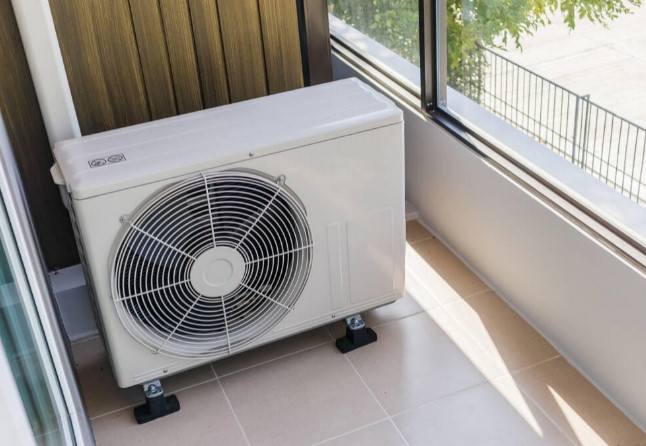Are you split on the decision to get a mini-split system? Some advice from your local HVAC company in Delaware might help. There are many advantages to using a mini-split system for your home’s heating and cooling needs. Take a look at everything you need to know!
A mini-split system is a ductless heating and cooling system. Unlike systems that rely on networks of ducts to transfer air throughout your entire home, mini-split systems heat and cool one room at a time. What’s the advantage of this? These are the perks of mini-split systems:
- Perfect for Unique Cooling Needs: If you have some unusual cooling needs at your home, a mini-split system offers the flexibility and customization needed to get the job done. Each mini-split system is capable of heating and cooling up to five zones at a time using a single condenser. Many homeowners with existing spaces that can’t be retrofitted without drastically altering a room prefer this option. For example, someone remodeling a gorgeous Victorian home without ducts may find that a mini-split system is a perfect option.
- Individual Control for Every Room: Every room becomes its own zone with a mini-split system. That means that you can easily customize the office, the kitchen, the bedroom, or the baby’s room to ensure that everyone is enjoying their own ideal temperature.
- Energy Efficiency: “Duct losses can account for more than 30% of energy consumption for air conditioning, especially if the ducts are in an unconditioned space such as an attic,” according to the U.S. Department of Energy. Mini-split systems are much more energy efficient than traditional central air conditioning for this reason! In addition, mini-split systems use inverter compressors instead of rotary compressors to help homeowners save even more on energy costs. These systems allow you to only use the power level needed to maintain your desired set temperature. ENERGY STAR-certified mini splits use up to 60% less energy than standard home electric radiators.
- Easy Installation: Mini-split systems typically only need a small hole placed through a wall to accommodate a conduit. In addition, manufacturers typically provide conduits of varying lengths to allow homeowners to heat and cool rooms on a home’s front side using a compressor that’s “hidden” in the back portion of the yard.
- Quiet Performance: Newer mini-split systems are designed with whisper-quiet performance.
- Bonus Features: Mini-split systems do some heavy lifting in your home. First, they actually help to remove humidity in your home. The evaporator coil in a mini-split system collects condensation. These systems also filter the air in your home.
If you have an older home, a mini-split system may be the only option for updating your heating and cooling system without taking on a major construction project. However, plenty of people in newer homes choose this option for all of the reasons listed above. Ultimately, you’re getting customization and zoning for the lowest price possible.
How Do Mini-split systems Work?
The “split” in mini-split systems comes from the fact that these systems are composed of two major components. The first half is an outdoor compressor/condenser. The second is an indoor air-handling unit that acts as your evaporator. A quick installation using a small hole through your wall to accommodate a conduit is all that’s needed to get these two components connected.
How Do I Know If This Is the Right Choice?
There are several ideal scenarios for installing a mini-split system over other options. It’s important to point out for a second time that mini-split systems are ideal for both historic homes and new constructions. Here’s a rundown of some ideal scenarios for mini-split systems:
- Members of your household are constantly arguing over the “right” temperature.
- You have rooms in your home that are only used at certain times. This can include bedrooms, offices, guest rooms, or attic rooms.
- You’ve recently added a new addition that doesn’t have ductwork.
- Certain rooms in your house have ultra-specific heating and cooling needs. Mini-split systems are commonly chosen for sunrooms. Mini-split systems are also commonly used in garages because it’s generally illegal to add ductwork to a garage due to safety risks. Some people like mini-split systems for primary bedrooms because these bedrooms are often located the furthest away from a home’s central HVAC system. Finally, mini-split systems are great for finished basements because they allow you to turn the square footage into livable space without altering ductwork.
- You’re building a slab home. The truth is that slab homes lack good options for heating and cooling due to the missing basement. Mini-split systems can often provide the best performance. Mini-split systems are also used commonly when building “tiny” homes.
- You want a cheap way to keep pets comfortable while you’re away at work all day. A mini-split system can be a great choice if you’re keeping pets safely confined in one area of a home while you’re at work because you can ensure that your pets are comfortable without paying to keep the whole house at a specific temperature.
It’s worth exploring a mini-split system if any of these scenarios apply to you. However, mini-split systems aren’t necessarily ideal for everyone. Next, take a look at some disadvantages to know about if you’re considering installing a mini-split system at your home.
What Are the Downsides?
Many people assume that the simplicity of the mini-split system means that these systems cost practically nothing. In reality, some systems come with pricing that’s comparable to what you’d pay for a traditional HVAC system. The cost savings with this option generally come once you begin saving on energy costs.
It’s also important to know that getting all of the benefits that go along with a mini-split system requires you to select a system that’s the perfect size for your home. Selecting a system that’s too big can cause a problem known as “short cycling.” If this issue happens, it will cut through any energy savings you were betting on. Going too small will leave you with an ineffective system. Proper installation is also essential. While some people try to cut costs by installing their mini-split systems on their own, this is not a DIY project. Improper installation can result in an inefficient system that wastes energy on getting your home to its ideal temperature.
The last downside to know about has to do with aesthetics. Mini-split systems aren’t as “invisible” as central air. The indoor part of the system will be visible. However, these systems are far less obtrusive than a visible window unit!
How Long Will a System Last?
A homeowner can expect a high-quality, properly installed mini-split system to last up to 20 years. However, proper maintenance is essential for extending the life of a mini-split system. Many people assume that the “ease” of a mini-split system means that no upkeep is required. Unfortunately, these neglected units can easily burn out long before they should if they aren’t being seen by a local HVAC professional regularly.
Talk to HVAC Professionals in Delaware
Delaware Heating & Air Conditioning can answer all your questions about getting a mini-split system installed in Delaware. Our team will be happy to assess your HVAC needs to help you decide if this is a wise, efficient option. We can also offer insights on how to go about installing a mini-split system at your home. We’re proud to offer mini-split systems from the best brands on the market today. Delaware Heating & Air Conditioning technicians offer the certifications and experience you’re looking for when having a mini-split system professionally installed at your home in Delaware. If you decide that a mini-split system isn’t the right option, we can help you find a better fit based on your heating and cooling needs. Contact us today for a consultation!


Recent Comments